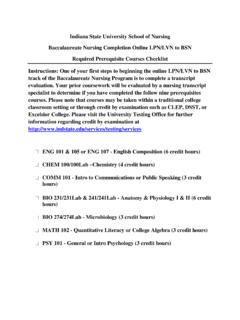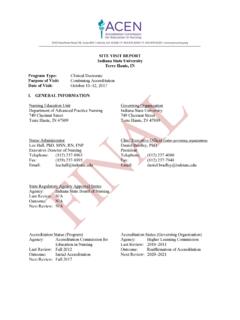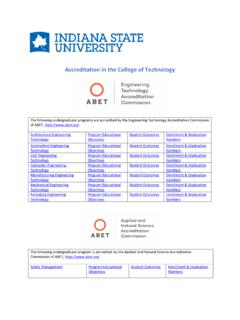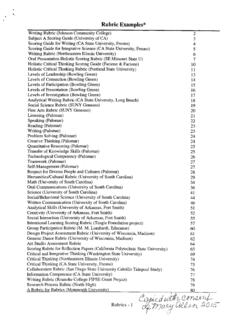Transcription of Developing Writing Skills from Sentence to Paragraphs
1 Developing Writing Skills from Sentence to ParagraphsPower of Reading SummitNovember 20, 2017 John WolfIndiana Academic Standards for WritingIndiana Academic Standards require students to become proficient in multiple text types Handwriting Persuasive Informative Narrative The research ProcessWhat Works ClearinghouseFive Recommendations for Teaching Common Core Grammar to Elementary StudentsCritical Foundational Skills Transcription Skills Handwriting Spelling Composition Skills Words to sentences, Paragraphs , and essays Creating, organizing, elaborating ideas Editing, revising, sharing (Berninger& Winn, 2006; McCloskey & Perkins, 2012) Handwriting Linked to better letter perception, reading fluency, and Writing fluency (Berninger, 2012; Graham, Harris, & Fink, 2000) Trains the orthographic loop, which supports spelling and composing.
2 Trains serial organization Automaticity quickly, accurately, effortlessly Reduces cognitive load needed for composition Why Handwriting Instruction? to form letters by hand improves perception of letters and contributes to better reading and letter Writing promotes better composing both amount written and quality of Writing . (Berninger, 2012) What about Keyboarding?SpellingSpelling instruction: in the early grades is linked to better composition in the later grades. (Berninger& Fayol, 2008) is linked to greater phonological awareness and reading proficiency (Graham & Santangelo, 2011) Oral Language Skills Vocabulary Writers must be able to spontaneously recall words and have a clear understanding of word meaning and usage.
3 (Corona, Spangenberger, & Venet, 1998) Sentence construction practice in combining simple, short sentences into complex sentences improves Writing quality (Saddler & Graham, 2005) Writing ProcessExplicit instruction in the Writing process plan, draft, revise, edit, and publish is supported by multiple studies. (Graham & Perin, 2007) Writing Instruction Strategy instruction is effective in increasing overall quality of students Writing (Graham, 2006) and has long-term impact (Fidalgo, Torrance, & Garcia, 2008) Instruction should include: task-specific strategies ( , using graphic organizers) and metacognitive strategies ( , using a rubric to evaluation your draft) Writing Instruction Recommendations Provide ample time for Writing Use frequent assessment to inform instruction Explicitly teach Writing Skills , process and strategies Teach multiple text types Write across the curriculum Integrate appropriate technology Establish a positive environment for Writing (Graham, 2013) Writing the lesson a catchy name.
4 It brief. on 1 key learning concept. the student know up front what they will be learning. by connecting the lesson with what they already know or are already doing. 6. Be explicitand direct. 7. Expect students to be accountable for their learning. 8. Plan mini-lessonsbased on what your students need to know. 9. Once is never enough! Model for Explicit Teaching in Writer s Workshop I ll Show YouYou Help MeI ll Help YouNow You Do It YourselfTeacher demonstration in mini-lessons: Te a c h e r h a s a l l t h e responsibility for the Writing Class participation in mini-lessons: The teacher has the most responsibility for the Writing and the children contribute as they are able At-the-elbow conferences: The child has the most responsibility for the Writing and the teacher provides support as needed.
5 Independent Writing : The child has all the responsibility for the Writing Teacher Responsibility Student Responsibility Tex t Structure to Improve Reading ComprehensionUnderstanding text structure Narrative -Tells a story, often about personal events or other life experiences; may be fiction or nonfiction Informational -Convey facts, describe procedures, explain something, share basic information, relate cause-effect, compare/contrast, problem-solution structures Tex t Structure Strategy: I I wonder .. I think .. I learned .. This reminds me of .. I am surprised .. I want to know .. (Step Up To Writing , Grades K-2 Auman, 2016 Free Response ask students to record (oral or written) a response to queries such as: Ask and Answer Questions about a Text Narratives Who are the characters?)
6 Who is the story about? What is the story about? What is the problem? What might happen? When does the story take place? Where does the story take place? Where do the characters go? Why does the character do this? Why does the character feel this way? How would your retell the story? How would you describe the character? How does the character solvethe problem? (Step Up To Writing , Grades K-2 Auman, 2016) Ask and Answer Questions about a Text Informational What is the topic of the text? What information did you learn? Who is involved? When did this happen? When would you use this information? Where did this happen? Where would you see this in the world? Why is this topic important?
7 Why did this happen? How would your describe this to someone else? (Step Up To Writing , Grades K-2 Auman, 2016) Writing Composition Skills Print conventions capitalization, punctuation, grammar, spelling Language usage and style Ideas and content Organization Writing Process Prewrite or draw think about a topic Plan organize ideas Draft write or tell first copy Revise make Writing more clear and interesting Edit word usage, spelling, capitals, punctuation Final copy and proofread Share and publish Sentence Writing Learning parts of speechWho or WhatActionWhere,When or HowFirst TryThe dogIs runningawayBetter SentenceSentence Writing More parts of speechWhatActionHowWhereCombining Sentences The boy drank boy was thirsty.
8 The weather was perfect. The girls were playing soccer. Writing ParagraphsThree- Sentence Paragraph Topic title Growing Pumpkins Beginning Sentence Pumpkins grow in gardens. Two important ideasThey are big and can make pumpkin pie from pumpkins. Deepen Vocabularies with Definitions Word Category Is like Is not like Definition Connection to self Describing with the 5 SensesSeeHearSmellFeelTasteQUESTION-to solicit more details: What type of .. Is that When does What color Always follow with HOW CAN YOU ADD THOSE DETAILS? The focus should be on How can you add them? not Would you like to Some Positive Things to Do or Say Your reader will like the way you Your reader can This piece is easy for me to read.
9 How did you learn that? I do the same Tell me again what happened. Did you put it down that way? What else do you want the reader to know? How did you select the topic? I see you have included some words from the word wall. I see you of MeaningTemperature_____ _____ _____ _____ steamy frigid chilly tepidInformation WritingOne Paragraph Structure Topic Sentence Key idea Examples, explanations, events, experiences Concluding Sentence (Step Up To Writing , Grades K-2 Auman, 2016) Informative WritingLonger Paragraph Structure Topic Sentence Key ideaExamples, explanations, events, experiences Key ideaExamples, explanations, events, experiences Key ideaExamples, explanations, events, experiences Concluding Sentence (Step Up To Writing , Grades K-2 Auman, 2016) Title: ElephantsTopic: Two kinds of elephantsConclusion.
10 (Step Up To Writing , Grades K-2 Auman, 2016) Persuasive WritingSimilar structure as informative writingTopic Key idea Examples, explanations, events, experiencesConclusion(Step Up To Writing , Grades K-2 Auman, 2016) Topic/Opinion : Best snacksSnacks Why they are the best(Step Up To Writing , Grades K-2 Auman, 2016) Narrative WritingFiction and nonfiction Real or imagined experiences and events Teach strategies to write a beginning, middle and ending Steps to Writing a StoryStep 1 Use 1 way to start: Tell who, where, when, or an action Step 2 What happens next? Step 3 Add more details. (Step Up To Writing , Grades K-2 Auman, 2016) Ways to End a Story Share a feeling Remember a character Share what the character may have learned research Reports Model the research process by leading shared classroom research projects.











